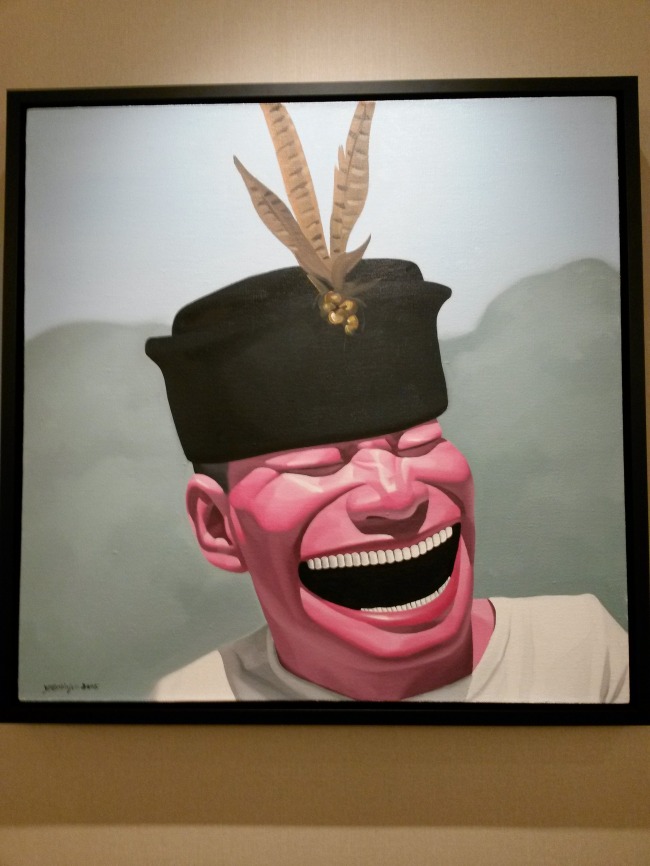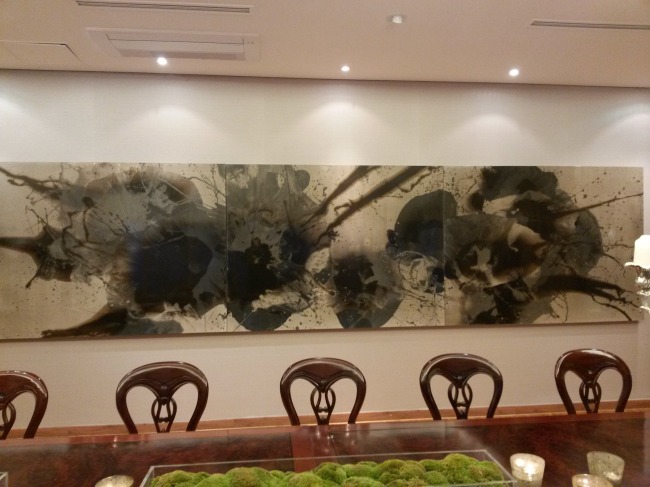This is the second in a series of articles in which foreign envoys to South Korea show the art of their countries displayed in their homes. ― Ed.
It is no accident that guests visiting the residence of the Indonesian ambassador here are greeted by art works from some the most sought-after East Asian artists.
Signature works by South Korea’s Park Sae-bo, Indonesia’s Arin Dwihartanto Sunaryo ― who was one of the hottest artists last year in April at a Sothby’s auction in Hong Kong ― and Yue Minjun of China decorate the rooms of all functions, including noisy official receptions, intimate dinner parties, even stuffy business meetings.
 |
| Indonesian Ambassador to South Korea John Prasetio (right) and his wife Alexandra at their residence in Yeouido, Seoul. (Yoon Byung-chan / The Korea Herald) |
 |
| Chinese artist Yue Min-jun’s untitled work of a smiling man wearing a traditional Indonesian hat. (Philip Iglauer/ The Korea Herald) |
The interior design of any ambassadorial residence including the art hanging on its walls ― in the case of Indonesian Ambassador John Prasetio and his wife, Alexandra, especially the art hanging on the walls ― serves a very deliberate purpose.
“I want to keep the Indonesian-ness of this embassy but, at the same time, I would like to project contemporary Indonesia,” explained Prasetio during an interview with The Korea Herald. “I had already learned that there was a misperception of Indonesia, as though they are thinking of the Indonesia of the 1970s.”
The dozen-odd artworks that compete for space in his home make you feel like you really are some place special but, as his country’s top diplomat here, Prasetio’s home is not only for living, it is a work space, too.
“Changing perceptions has to start with ourselves. ‘We’ are very positive. We both like Korean food, Korean art, and in particular Korean people,” he said, gesturing to Alexandra, sitting beside him. A veritable diplomatic duo, the couple is often seen together at public events around town.
“The response has been very positive,” Alexandra added. “We are seeing progress in changing the perception. That has been very encouraging.”
Alexandra knows something about utilizing interior space for entertaining. She is an architect and interior designer by training, as well as an astute collector of fine art. When she and her husband first arrived in South Korea nearly two years ago, she saw in her new home untapped potential.
She replaced a north-facing wall with windows, bringing in abundant natural light and a view of the garden.
Alexandra explained that the simple renovation transformed a dimly lit prep area into “one of the best rooms in the house.”
The new source of natural light flooding the dining room and the sitting room Alexandra uncovered helps direct attention to many works by young Indonesian artists that she and her husband have put out on display.
Works by three Indonesian artists stand out as great examples of why the Southeast Asian country has become the place from where some of the most daring new art is coming.
The centerpiece of the dining room is a triptych by arguably one of the most sought-after Southeast Asian artist in 2013, Arin Dwihartanto Sunaryo.
 |
| Indonesian artist Arin Dwihartanto Sunaryo’s three-panel “Volcanic Ash” (2012). (Philip Iglauer/ The Korea Herald) |
Alexandra is a personal friend of Sunaryo and acquired the work in 2012, one of the first of his “Volcanic Ash” series.
Months later in 2013, the Guggenheim Museum in New York City sensed a rising star in the art world, and acquired “Volcanic Ash Series #4,” she said.
“When Gunung Merapi erupted, (Sunaryo) gathered ashes from the eruption. He mixed the ash with pigment and resin,” she said about Sunaryo’s artistic process.
At 200 kilograms apiece, each of the three panels is very heavy, she said. “This is not a painting. He created layer after layer of it with lacquer. You can see how thick it is. He wanted to show his emotions with this.
“When the volcano erupted, you can see in it, the powerful flash and the debris,” she said
The Guggenheim on its website described the triptych as a combination of resin and, as pigment, volcanic ash from the 2010 eruption of the most active volcano in Indonesia.
The couple explained that they want the art in the residence to project what could be an unfamiliar image of Southeast Asia’s largest country: an image of modern sophistication and creativity.
They said that people in South Korea, and in many countries for that matter, should know Indonesia as “a modern and populous country brimming with creativity.”
Another work by an Indonesian artist currently popular in the world of culture is an untitled piece by Putu Sutawidjaya.
Greeting visitors in the ante room of the residence are naked androgynous devotees’ contorting before abstracted calendars and bold numerals centrally located on a broad canvas measuring some two square meters. It is work imbued with religiosity.
In the dining room accompanying Sunaryo’s ode to the power of Mother Nature is another kind of homage, one to self discovery, by Christine Ay Tjoe. Although bright and colorful, Tjoe’s art work is acutely personal, indeed, even vulnerable.
Alexandra explained that Ay Tjoe was inspired by the Old Testament story of the prodigal son in the 2006 painting. In it the artist explores the need for mutual dependence, as well as the need for hope, love and forgiveness in a relationship.
By Philip Iglauer (ephilip2014@heraldcorp.com)

